Wildflowers of the Adirondacks:
Wild Sarsaparilla (Aralia nudicaulis)
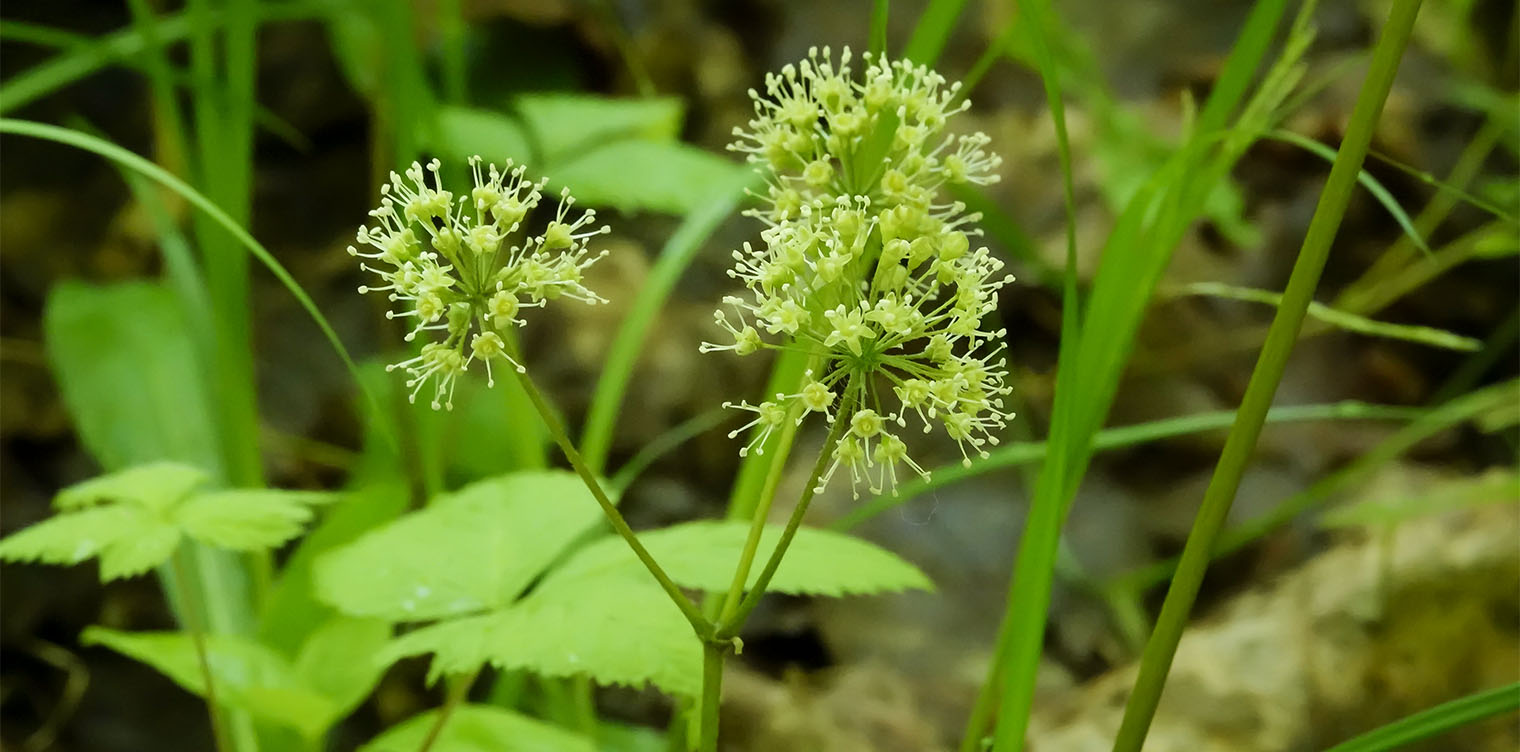
Wild Sarsaparilla (Aralia nudicaulis) is a wildflower that produces globe-shaped clusters of greenish-white flowers in spring in the Adirondack Mountains of upstate New York. The finely toothed compound leaves are bronze in spring, green in summer, and yellow or red in the fall.
- Wild Sarsaparilla is a member of the Araliaceae (Ginseng) Family, which also contains two other somewhat similar plants found in the Adirondack Mountains: Dwarf Ginseng (Panax trifolius) and American Ginseng (Panax quinquefolius).
- Wild Sarsaparilla is part of the Aralia (Spikenard) genus. This genus also includes Spikenard (Aralia racemosa L.) and Bristly Sarsaparilla (Aralia hispida), both of which are found in the Adirondack Park. The genus name (Aralia) is a Latinization of an old French-Canadian name, which may have been derived from the Iroquois language.
- The species name (nudicaulis) comes from the Latin nudus (meaning naked) and cauli (stalk). This is a reference to the fact that the flower stalk is leafless.
The common name (Wild Sarsaparilla) refers to the former use of the plant's root as a substitute for sarsaparilla in making root beer. Alternate common names include Rabbit Root (a reference to reports that the plant is tasty to rabbits), False Spikenard, Small Spikenard, Sweet-root, Virginia-sarsaparilla, American-Sarsaparilla, and Wild Licorice.
Identification of Wild Sarsaparilla
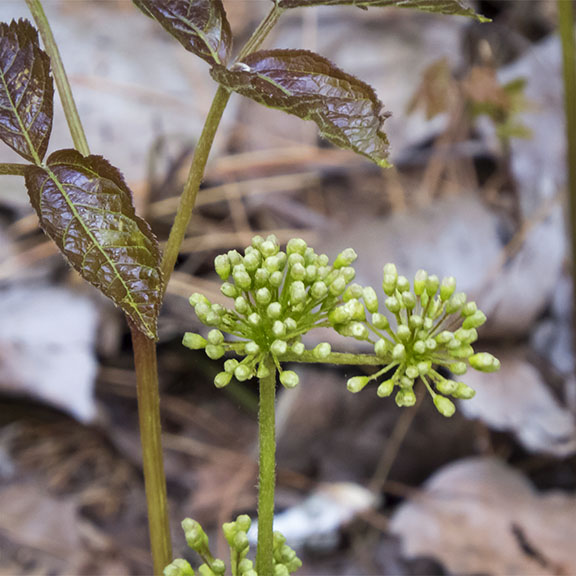
Wild Sarsaparilla reaches a height of 8 to 20 inches. The leaf stem and flowering stem are hairless and arise from an aromatic root system consisting of fibrous secondary roots and a long horizontal rhizome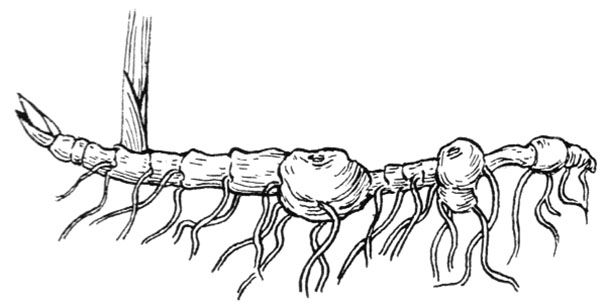 Rhizome: The modified subterranean stem of a plant that sends out roots and shoots from its nodes. Rhizomes are also called creeping rootstalks and rootstocks. that run about two inches below the soil.
Rhizome: The modified subterranean stem of a plant that sends out roots and shoots from its nodes. Rhizomes are also called creeping rootstalks and rootstocks. that run about two inches below the soil.
This plant produces a single leaf with a long, smooth stalk, growing above the flowers like an umbrella.
- The leaf is basalBasal: Leaves are confined to the base of the stem. , meaning that it arises from the base of the plant.
- The leaf is compound
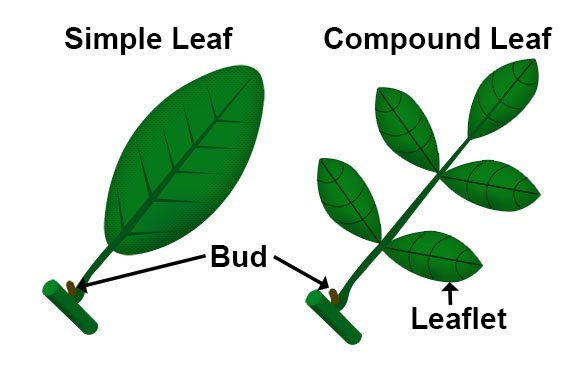 Compound Leaf: A leaf that is divided to the midrib, with distinct, expanded portions called leaflets., meaning that it is divided into several leaflets. In the case of Wild Sarsaparilla, the leaf is twice divided. It is divided into three parts and further divided into five leaflets, each of which is two to five inches long. The leaf is pinnately compound
Compound Leaf: A leaf that is divided to the midrib, with distinct, expanded portions called leaflets., meaning that it is divided into several leaflets. In the case of Wild Sarsaparilla, the leaf is twice divided. It is divided into three parts and further divided into five leaflets, each of which is two to five inches long. The leaf is pinnately compound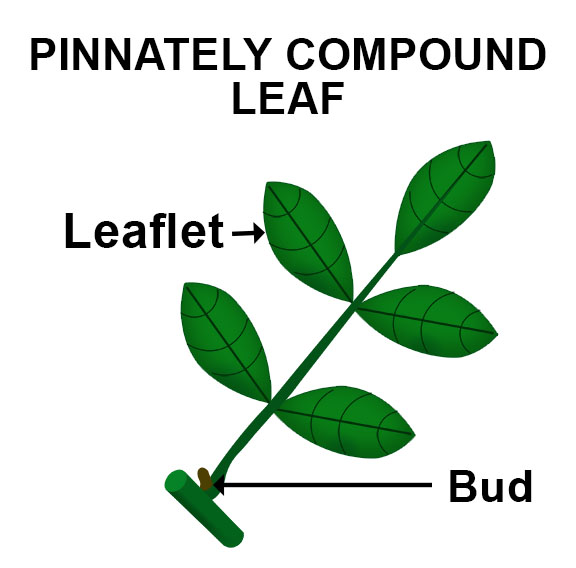 Pinnately Compound Leaf: A type of compound leaf. In pinnately compound leaves, a row of leaflets forms on either side of an extension of the petiole called the rachis., which means that the leaflets are borne in rows on either side of a central axis.
Pinnately Compound Leaf: A type of compound leaf. In pinnately compound leaves, a row of leaflets forms on either side of an extension of the petiole called the rachis., which means that the leaflets are borne in rows on either side of a central axis. - The leaflets are narrowly oval, with a pointed tip. The margins (edges) are finely toothed.
- Wild Sarsaparilla leaves are a deep bronze when they emerge in the spring, changing to medium green during the summer. As the weather gets colder in the fall, the leaves change to yellow or deep red.
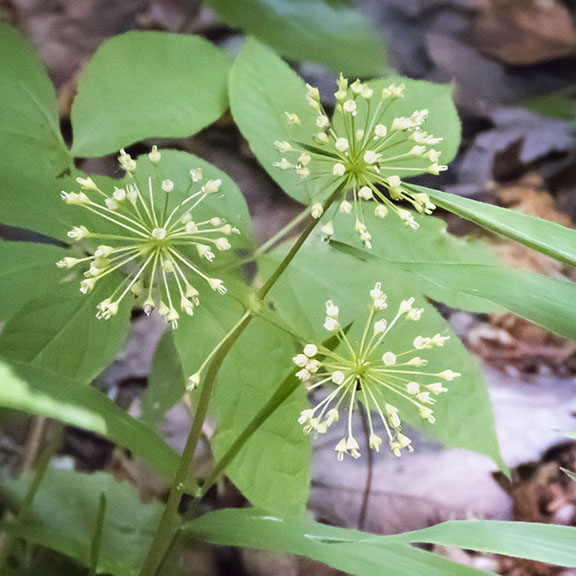
In spring, the plant produces three flower clusters on a leafless stalk arising directly from the base of the plant.
- The flower cluster (sometimes referred to as an inflorescence in guidebooks) is an umbel
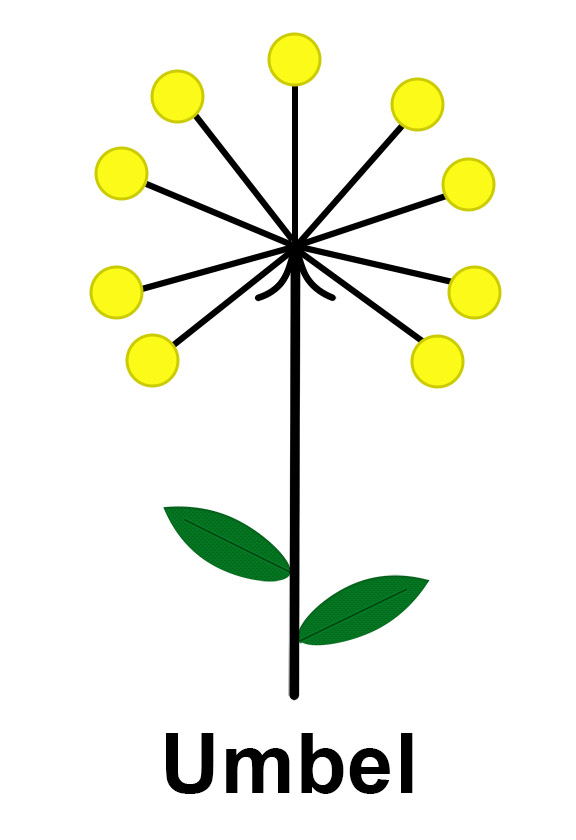 Umbel: A flower arrangement in which the flowers appear at the end of
a number of short flower stalks (called pedicels), spreading from a common point like umbrella ribs, usually resulting in a flat- or round-topped inflorescence.
, meaning that is consists of a number of short flower stalks (called pedicels
Umbel: A flower arrangement in which the flowers appear at the end of
a number of short flower stalks (called pedicels), spreading from a common point like umbrella ribs, usually resulting in a flat- or round-topped inflorescence.
, meaning that is consists of a number of short flower stalks (called pedicels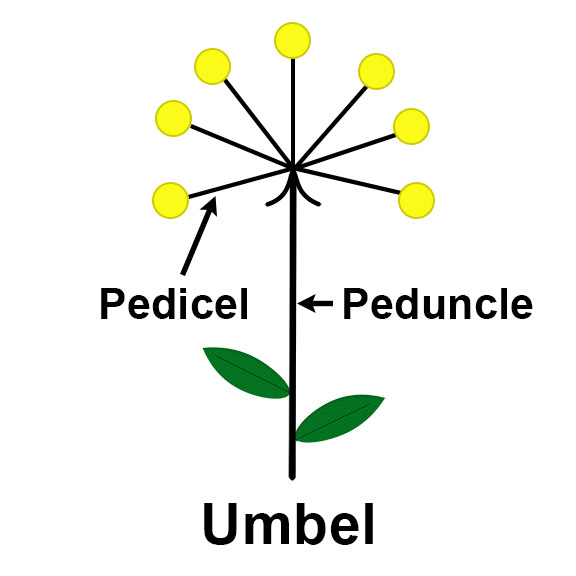 Pedicel: A small stalk bearing an individual flower in an inflorescence (flower cluster).
), spreading from a common point like umbrella ribs.
Pedicel: A small stalk bearing an individual flower in an inflorescence (flower cluster).
), spreading from a common point like umbrella ribs. - Wild Sarsaparilla's umbels are spherical. Most guidebooks indicate that the umbels are 1½–2" across, but in our region the flower clusters are usually somewhat smaller.
- Each flower cluster consists of about twenty to forty flowers. Each flower is about ⅛ inch wide. Each flower has five petals that curve back and downward, five white-tipped stamens
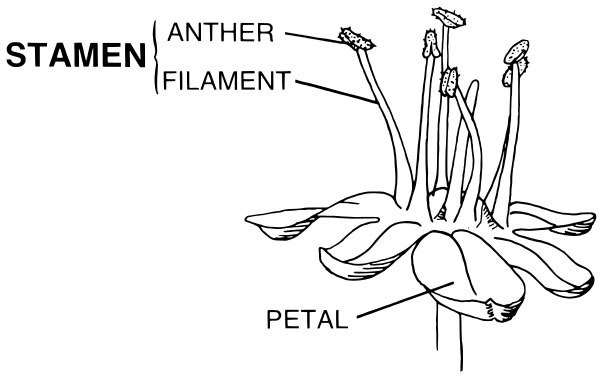 Stamen: The male part of the flower, made up of the filament and anther. that protrude from the center, and a pistil
Stamen: The male part of the flower, made up of the filament and anther. that protrude from the center, and a pistil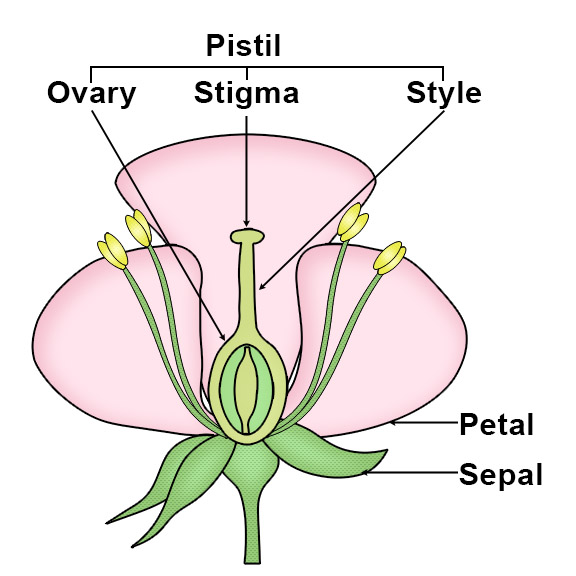 Pistil: The female organs of a flower, consisting of the ovary, stigma, and style.
with five styles
Pistil: The female organs of a flower, consisting of the ovary, stigma, and style.
with five styles Style: The narrow, elongated part of the pistil between the ovary and the stigma. The style is part of the pistil (the female organs of a flower), which also consists of an ovary and a stigma. The style is the stalk that connects the stigma to the ovary. . The pedicels
Style: The narrow, elongated part of the pistil between the ovary and the stigma. The style is part of the pistil (the female organs of a flower), which also consists of an ovary and a stigma. The style is the stalk that connects the stigma to the ovary. . The pedicels Pedicel: A small stalk bearing an individual flower in an inflorescence (flower cluster).
– the small stalks bearing an individual flower in a flower cluster – are pale green.
Pedicel: A small stalk bearing an individual flower in an inflorescence (flower cluster).
– the small stalks bearing an individual flower in a flower cluster – are pale green. - The stalk bearing the flowers is considerably shorter than the leaf stalk, so the flower clusters tend to be hidden beneath the leaf.
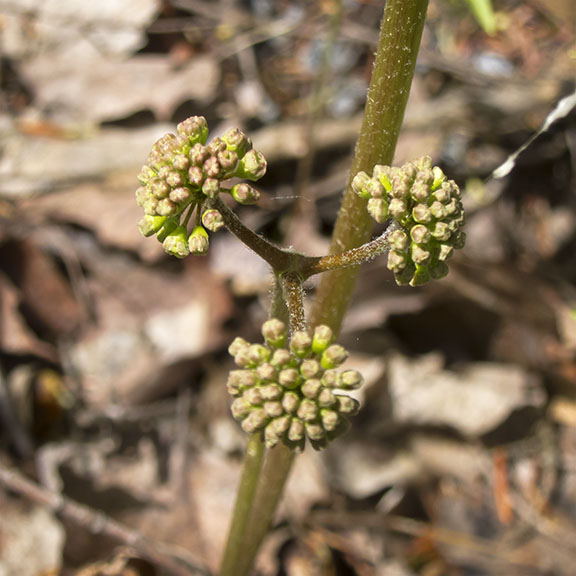
Wild Sarsaparilla generally blooms in late spring in the Adirondack Mountains.
- A tally of flowering dates for the upland Adirondack areas compiled by Michael Kudish, based on data collected from the early seventies to the early nineties, lists the plant as in flower from 25 May through 12 June, with a median flowering date of 3 June.
- More recent data suggest a similar pattern. In the northern part of the Adirondack Park, Wild Sarsaparilla is generally in bud in mid- to late May and in flower in early to mid-June.
- In the southern part of the Adirondacks and areas just south of the Adirondack Park Blue Line, blooms may appear a few weeks earlier, in early May.
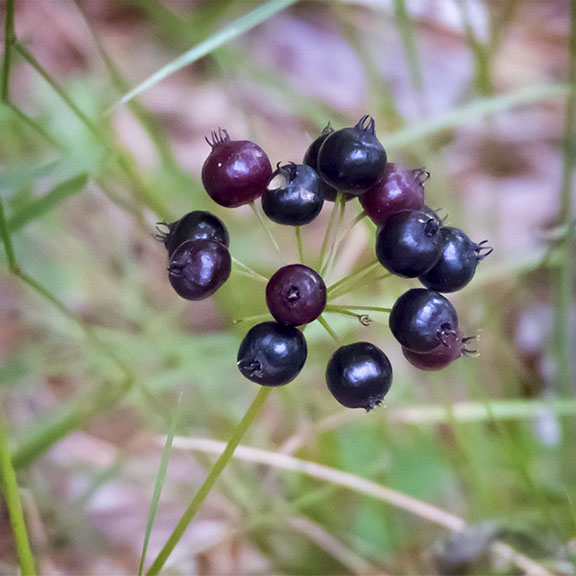
Wild Sarsaparilla's flowers develop into fruit which takes the form of a ¼-inch round green berry. The berries appear in a cluster and change from green to reddish green to dark purple or blue-black. Each berry contains an average of five small seeds The berries are said to taste a little spicy and sweet.
Keys for distinguishing Wild Sarsaparilla from the two other plants in the Aralia genus that grow in the Adirondacks include its size and the shape of its flower cluster (inflorescence).
- The flower clusters of Spikenard (Aralia racemosa) are racemes
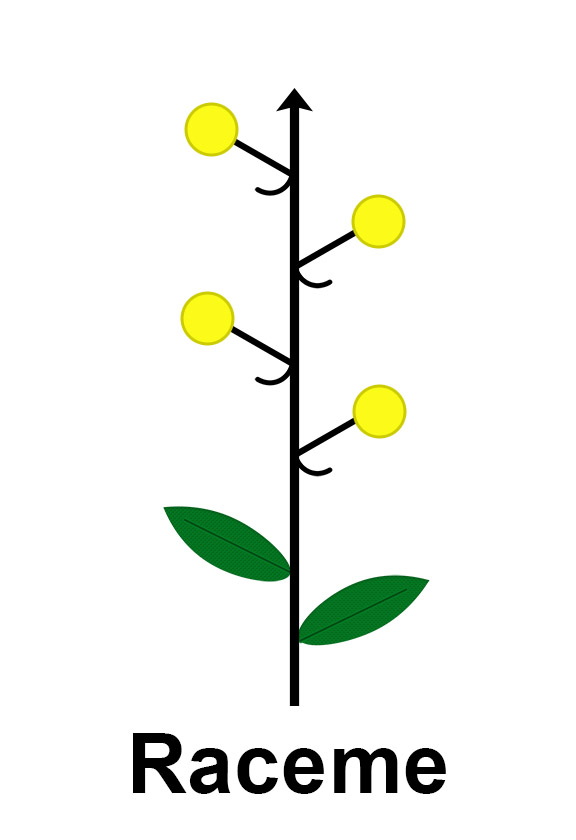 Raceme: A flower cluster with the separate flowers attached by short equal stalks at equal distances along a central stem. , with the flowers attached by short stalks along a main axis, in contrast to the rounded flower clusters of Wild Sarsaparilla. In addition, Spikenard's flowers are densely covered in very short white hairs, which give them a frosty look; and its berries are purplish red. Also, Spikenard is a much larger plant, growing three to four feet high.
Raceme: A flower cluster with the separate flowers attached by short equal stalks at equal distances along a central stem. , with the flowers attached by short stalks along a main axis, in contrast to the rounded flower clusters of Wild Sarsaparilla. In addition, Spikenard's flowers are densely covered in very short white hairs, which give them a frosty look; and its berries are purplish red. Also, Spikenard is a much larger plant, growing three to four feet high. - Bristly Sarsaparilla (Aralia hispida) has stout stems with long sharp bristles in the lower parts of the plant, in contrast to Wild Sarsaparilla's smooth stems.
Wild Sarsaparilla's flowers are similar to those of two plants in the Ginseng (Panax) genus that occur in the Adirondacks.
- American Ginseng (Panax quinquefolius) also produces tiny greenish white flowers arranged in round clusters (umbels). However, its compound leaves are palmate
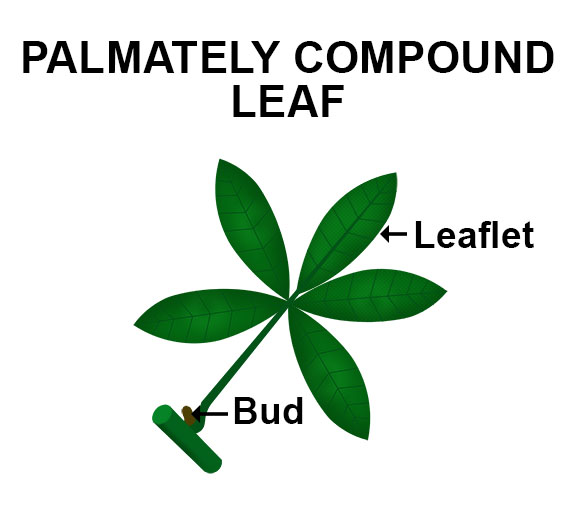 Palmately Compound Leaf: A type of compound leaf. In palmately compound leaves, the leaflets radiate from a single point., with the leaflets radiating from a single point, in contrast to Wild Sarsaparilla's compound leaves, which are pinnate
Palmately Compound Leaf: A type of compound leaf. In palmately compound leaves, the leaflets radiate from a single point., with the leaflets radiating from a single point, in contrast to Wild Sarsaparilla's compound leaves, which are pinnate Pinnately Compound Leaf: A type of compound leaf. In pinnately compound leaves, a row of leaflets forms on either side of an extension of the petiole called the rachis. (with the leaflets attached along on extension of the petiole called a rachis). Moreover, its berries are bright red, in contrast to the purplish black berries of the Wild Sarsaparilla.
Pinnately Compound Leaf: A type of compound leaf. In pinnately compound leaves, a row of leaflets forms on either side of an extension of the petiole called the rachis. (with the leaflets attached along on extension of the petiole called a rachis). Moreover, its berries are bright red, in contrast to the purplish black berries of the Wild Sarsaparilla. - Dwarf Ginseng (Panax trifolius) also produces a cluster of tiny white flowers, but it is a much smaller plant than Wild Sarsaparilla; and its flower clusters (which are snowy white, lacking the greenish tinge of Wild Sarsaparilla flowers) appear above or at the same height as the leaves, rather than huddled below the leaves, as with Wild Sarsaparilla.
Uses of Wild Sarsaparilla
Wild Sarsaparilla derives its common name from the fact that it was used in the past a substitute for sarsaparilla and for making root beer. The plant was reportedly used as food by the Indians during wars or when they were hunting since it is very sustaining. It was also used by native Americans to make teas. The Algonquin, Montagnais, and Iroquois reportedly used the berries to make wine. The Kwakiutl roasted the roots for food.
This plant had a much wider use among native Americans as a medicine to treat a wide variety of ailments. A number of groups, including the Mohegans, Abnaki, Cherokee, and Delaware, used the plant as a tonic. Wild Sarsaparilla was also used by many groups as a poultice for wounds, burns, or sores. The root was also used as a cough medicine.
Wildlife Value of Wild Sarsaparilla
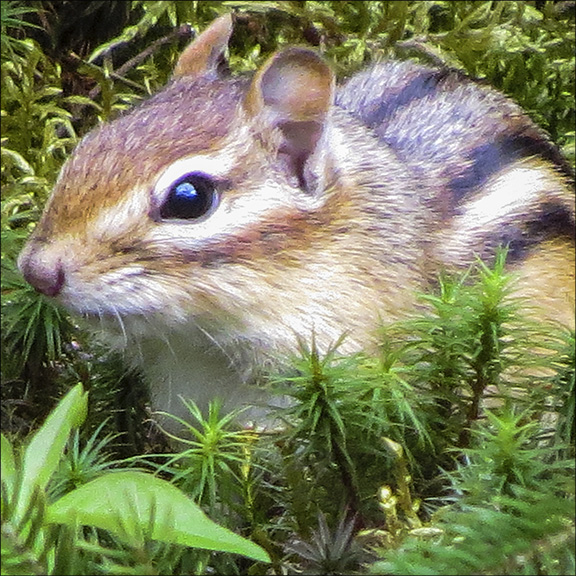
Wild Sarsaparilla is used as a food source for a variety of birds, mammals, and insects, although the overall wildlife value of these plants is low.
- Long-tongued and short-tongued bees, as well as some species of flies and beetles, visit the flowers. At least one species of aphid feeds on the roots and stem bases.
- The berries of Aralia species are consumed by the Hermit Thrush, Wood Thrush, Swainson's Thrush, Ruffed Grouse, and White-throated Sparrow, although this represents only a small percentage of their diets.
A few mammals feed on Wild Sarsaparilla.
- Wild Sarsaparilla is browsed by White-tailed Deer and Moose.
- Eastern Chipmunks, Striped Skunks, and Red Foxes consume the berries.
- American Black Bears are also consumers of Wild Sarsaparilla berries, although sources conflict on their relative importance in the bears' diet. Studies analyzing bear scat in Ontario, Quebec, northern Wisconsin, and northeastern Minnesota found that berries from Wild Sarsaparilla were an important food item of Black Bears in July and August. Most analyses found that Black Bear diets vary significantly with the seasonal availability of both Wild Sarsaparilla berries and alternate food sources.
Distribution of Wild Sarsaparilla
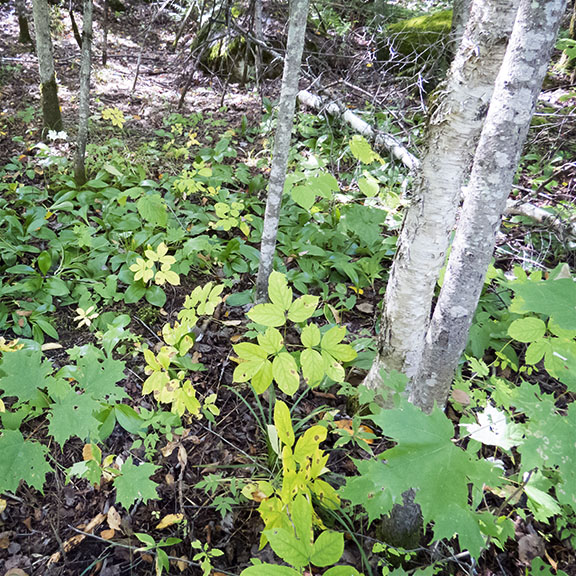
The range of Wild Sarsaparilla includes Alberta east to Newfoundland, south to Georgia, and northwest to Nebraska and North Dakota. There are also populations of this plant in the northwestern US and British Columbia.
Wild Sarsaparilla is found in many New York counties. Its presence has been documented in all counties within the Adirondack Park Blue Line except Clinton, Saratoga, and Fulton.
Habitat of Wild Sarsaparilla
Wild Sarsaparilla is relatively flexible in terms of site requirements. It is adapted to coarse, fine, and medium textured soil. It can grow in soils that are moderate to rich in nutrients and on sites that are poorly drained to well-drained. It is shade-tolerant. Its preference appears to be for lightly shaded open woods, but it can also be found in full shade.
As a result, Wild Sarsaparilla can be found in a wide range of habitats, including lowland conifer and mixed woods forests, as well as thickets and bog edges. It can be found growing under both conifers and deciduous trees.
In the Adirondack Mountains, Wild Sarsaparilla is found in a variety of ecological communities, including:
- Acidic Talus Slope Woodland
- Appalachian Oak-Hickory Forest
- Appalachian Oak-Pine Forest
- Balsam Flats
- Beech-Maple Mesic Forest
- Chestnut Oak Forest
- Hemlock-Hardwood Swamp
- Hemlock-Northern Hardwood Forest
- Mountain Spruce-Fir Forest
- Northern White Cedar Swamp
- Pine-Northern Hardwood Forest
- Pitch Pine-Heath Barrens
- Spruce-Northern Hardwood Forest
The Beech-Maple Mesic Forest, for instance, is a closed-canopy Northern Hardwood Forest dominated by Sugar Maple and American Beech, usually located on moist, well-drained soils. This ecological community is characterized by a good display of spring ephemerals in late April and early May.
- Yellow Birch and Red Maple are often present, as well as a few conifers (Eastern Hemlock or Red Spruce).
- The understory in this ecological community usually has an abundance of Sugar Maple and American Beech tree seedlings, and often includes Hobblebush and Striped Maple.
- Characteristic wildflowers, in addition to the Wild Sarsaparilla, include Canada Mayflower, Common Wood Sorrel, Jack-in-the-pulpit, Starflower, Foamflower, Indian Cucumber-root, Trout Lily, Whorled Wood Aster, Painted Trillium, and Purple Trillium.
- Characteristic ferns include wood ferns, Christmas Ferns, and Hay-scented Ferns.
- Characteristic birds that are seen and heard in this ecological community include Red-eyed Vireos, Ovenbirds, Black-throated Blue Warblers, and Black-throated Green Warblesr.
Look for Wild Sarsaparillas growing along virtually all of the trails covered here, including the Heron Marsh Trail and Boreal Life Trail at the Paul Smith's College VIC, the Loop Trail at Henry's Woods, Heart Lake Trail, Peninsula Nature Trails, Heaven Hill Trails, and Bloomingdale Bog Trail.
References
Michael Kudish. Adirondack Upland Flora: An Ecological Perspective (The Chauncy Press, 1992), pp. 23-28, 177.
New York Flora Association. New York Flora Atlas. Wild Sarsaparilla. Aralia nudicaulis L. Retrieved 11 July 2019.
Integrated Taxonomic Information System. Aralia nudicaulis L. Retrieved 18 February 2018.
United States Department of Agriculture. The Plants Database. Wild Sarsaparilla. Aralia nudicaulis L. Retrieved 19 February 2018.
United States Department of Agriculture. Fire Effects Information System (FEIS). Species Reviews. Aralia nudicaulis. Retrieved 19 February 2018.
NatureServe Explorer. Online Encyclopedia of Life. Wild Sarsaparilla. Aralia nudicaulis - L. Retrieved 19 February 2018.
Margaret B. Gargiullo. A Guide to Native Plants of the New York City Region (New York City Department of Parks & Recreation, 2007), pp. 96-97.
New England Wildflower Society. Go Botany. Wild Sarsaparilla. Aralia nudicaulis L. Retrieved 19 February 2018.
New York State. Department of Environmental Conservation. New York Natural Heritage Program. Ecological Communities of New York State. Second Edition (March 2014), pp. 71-72, 101-102, 107-108, 116, 117, 118, 119-120, 121, 122-123, 123-124. Retrieved 17 October 2015.
New York Natural Heritage Program. 2021. Online Conservation Guide for Acidic Talus Slope Woodland. Retrieved 24 July 2021..
New York Natural Heritage Program. 2021. Online Conservation Guide for Appalachian Oak-Hickory Forest. Retrieved 24 July 2021.
New York Natural Heritage Program. 2021. Online Conservation Guide for Appalachian Oak-Pine Forest. Retrieved 24 July 2021.
New York Natural Heritage Program. 2021. Online Conservation Guide for Balsam Flats. Retrieved 24 July 2021.
New York Natural Heritage Program. 2021. Online Conservation Guide for Beech-Maple Mesic Forest. Retrieved 24 July 2021.
New York Natural Heritage Program. 2021. Online Conservation Guide for Chestnut Oak Forest. Retrieved 24 July 2021.
New York Natural Heritage Program. 2021. Online Conservation Guide for Hemlock-Hardwood Swamp. Retrieved 24 July 2021.
New York Natural Heritage Program. 2021. Online Conservation Guide for Hemlock-Northern Hardwood Forest. Retrieved 24 July 2021.
New York Natural Heritage Program. 2021. Online Conservation Guide for Mountain Spruce-Fir Forest. Retrieved 24 July 2021.9.
New York Natural Heritage Program. 2021. Online Conservation Guide for Northern White Cedar Swamp. Retrieved 24 July 2021.
New York Natural Heritage Program. 2021. Online Conservation Guide for Pine-Northern Hardwood Forest. Retrieved 24 July 2021.
New York Natural Heritage Program. 2021. Online Conservation Guide for Pitch Pine-Heath Barrens. Retrieved 24 July 2021.
New York Natural Heritage Program. 2021. Online Conservation Guide for Spruce-Northern Hardwood Forest. Retrieved 24 July 2021.
New York State. Adirondack Park Agency. Preliminary List of Species Native Within the Adirondack Park Listed Alphabetically by Scientific Name and Sorted by Habit. Volume 1. Updated 10.23.2006, p. 15. Retrieved 26 January 2017.
USA National Phenology Network. Nature’s Notebook. Aralia nudicaulis. Retrieved 19 February 2018.
Connecticut Botanical Society. Wild Sarsaparilla. Aralia nudicaulis L. Retrieved 19 February 2018.
University of Wisconsin. Flora of Wisconsin. Aralia nudicaulis L. Retrieved 19 February 2018.
Minnesota Wildflowers. Aralia nudicaulis (Wild Sarsaparilla). Retrieved 19 February 2018.
Illinois Wildflowers. Wild Sarsaparilla. Aralia nudicaulis. Retrieved 19 February 2018.
Illinois Wildflowers. Vertebrate Animal & Plant Database. Aralia nudicaulis (Wild Sarsaparilla). Retrieved 19 February 2018.
Illinois Wildflowers. Insect Visitors of Illinois Wildflowers. Aralia nudicaulis (Wild Sarsaparilla). Retrieved 19 February 2018.
Illinois Wildflowers. Plant-Feeding Insect Database. Aralia nudicaulis (Wild Sarsaparilla). Retrieved 19 February 2018.
Eloise Butler Wildflower Garden. The Friends of the Wild Flower Garden. Wild Sarsaparilla. Aralia nudicaulis L. Retrieved 19 February 2018.
Lady Bird Johnson Wildflower Center. Aralia nudicaulis. Retrieved 19 February 2018.
iNaturalist. Adirondack All-Taxa Biodiversity Inventory. Wild Sarsaparilla. Aralia nudicaulis. Retrieved 19 February 2018.
Anne McGrath. Wildflowers of the Adirondacks (EarthWords, 2000), p. 10, Plate 5 .
Roger Tory Peterson and Margaret McKenny. A Field Guide to Wildflowers. Northeastern and North-central North America (Houghton Mifflin Company, 1968), pp. 50-51.
Doug Ladd. North Woods Wildflowers (Falcon Publishing, 2001), pp. 2-4, 158.
Lawrence Newcomb. Newcomb's Wildflower Guide (Little Brown and Company, 1977), pp. 182-183.
David M. Brandenburg. Field Guide to Wildflowers of North America (Sterling Publishing Company, Inc., 2010), p. 77.
John Kricher. A Field Guide to Eastern Forests. North America (Houghton Mifflin, 1998), pp. 72, 78, 81.
Timothy Coffey. The History and Folklore of North American Wildflowers (FactsOnFile, 1993), pp. 151-152.
William Carey Grimm. The Illustrated Book of Wildflowers and Shrubs (Stackpole Books, 1993), pp. 188-189.
National Audubon Society. Field Guide to North American Wildflowers. Eastern Region. (Alfred A. Knopf, 2001), pp. 354-356, Plate 169.
William K. Chapman et al. Wildflowers of New York in Color (Syracuse University Press, 1998), pp. 118-119.
Gary Wade et al. Vascular Plant Species of the Forest Ecology Research and Demonstration Area, Paul Smiths, New York. USDA Forest Service. Research Note NE-380, p. 5. Retrieved 22 January 2017.
Mark J. Twery, et al. Changes in Abundance of Vascular Plants under Varying Silvicultural Systems at the Forest Ecosystem Research and Demonstration Area, Paul Smiths, New York. USDA Forest Service. Research Note NRS-169. p. 7. Retrieved 22 January 2017.
Alexander C. Martin, Herbert S. Zim, and Arnold L. Nelson. American Wildlife & Plants. A Guide to Wildlife Food Habits (Dover Publications, 1951), pp. 348-349.
Plants for a Future. Aralia nudicaulis - L. Retrieved 19 February 2018.
Steven Foster and James A. Duke. A Field Guide to Medicinal Plants and Herbs of Eastern and Central North America. Second Edition. (Houghton Mifflin Harcourt, 2000), p. 63.
Lee Allen Peterson. A Field Guide to Edible Wild Plants. Eastern and Central North America (Houghton Mifflin Company, 1977), p. 40.
Bradford Angier. Field Guide to Medicinal Wild Plants. Revised and Updated. Second Edition, (Stackpole Books, 2008), pp. 230-231.
University of Michigan. Native American Ethnobotany. A Database of Foods, Drugs, Dyes and Fibers of Native American Peoples, Derived from Plants. Wild Sarsaparilla. Aralia nudicaulis L. Retrieved 19 February 2018.
Nancy G. Slack and Allison W. Bell. Adirondack Alpine Summits: An Ecological Field Guide (Adirondack Mountain Club, Inc., 2006), p. 18.
Allen J. Coombes. Dictionary of Plant Names (Timber Press, 1994), pp. 14-15.
Charles H. Peck. Plants of North Elba (Bulletin of the New York State Museum, Volume 6, Number 28, June 1899), p. 99. Retrieved 22 February 2017.
An Adirondack Naturalist in Illinois. First Walk of June. 3 June 2008. Retrieved 19 February 2018.
An Adirondack Naturalist in Illinois. More Musings from the Trail. 29 July 2008. Retrieved 19 February 2018.
Derrick A. Romain, James L. Atkinson, and Martyn Ernest Obbard,"Temporal variation in food habits of the American Black Bear (Ursus americanus) in the boreal forest of northern Ontario," The Canadian Field Naturalist, Volume 127, Number 2 (April 2013), pp. 118-130. Retrieved 21 February 2018.
Arnaud Mosnier, Jean-Pierre Ouellet and Réhaume Courtois "Black bear adaptation to low productivity in the boreal forest," Écoscience, Volume 15, Issue 4, 2008, pp. 485-497. Retrieved 21 February 2018.
Neil F. Payne, et al, "Black Bear Food Items in Northern Wisconsin," Transactions, Volume 86, 1998, pp. 263-280. Retrieved 21 February 2018.
Lynn L. Rogers, Gregory A. Wilker, and Arthur W. Allen, "Managing Northern Forests for Black Bears," A paper presented at the Society of American Foresters National Convention held at Minneapolis, Minnesota, on October 20, 1987. Retrieved 21 February 2018.
Claude Daigle, et al., "Summer Diet of Two White-tailed Deer, Odocoileus virginianus, Populations Living at Low and High Density in Southern Québec," The Canadian Field-Naturalist, Volume 118, Number 3 (2004), pp. 360-367. Retrieved 21 February 2018.
